Debunking the Biggest Myths of Mandatory Bicycle Helmet Law Advocates
13 October 2018
It’s crisis time for cycling in Australia, with recent reports showing cycling now in decline and safety not improving for the past 20 years. Anti-cycling laws and strategies like huge increases in cycling fines, heavier enforcement of helmet laws, targeted operations against other minor infringements like riding on footpaths and not no bell attached, and hysterical promotion that cycling is dangerous, are taking their toll. Meanwhile, for all other road users, safety has improved. It’s enough to make Bicycle Network, Australia’s largest bicycle lobby group, seriously question their rigid stance on helmets, especially when the nation’s supposedly “world leading” helmet laws only travelled as far as New Zealand. Where once Bicycle Network (formerly Bicycle Victoria) led the charge to ramp up cycling fines to earn “respect” from motorists and even twisted data to suggest cycling in Australia was safer than in the Netherlands, for the past year they’ve been in deep review, conducting comprehensive reviews into cycling safety, bicycle helmet wearing and the helmet law itself.

Cycling in Melbourne, Australia. Image: news.com.au
From their fatalities report, Bicycle Network found:
- There were were 742 bike rider fatalities between 1998 and 2017 at an average of 37 a year.
- The total number of bike rider deaths in 2017 was 38 – slightly above the annual average.
- Virtually no progress has been made in reducing bike rider fatalities over the last 20 years, while total fatalities among other road user groups has been declining (-9.1%).
- People riding bikes are killed in crashes with other motor vehicles (83%), with trucks and buses posing a significant risk (24%).
- The higher the speed, the more likely the crash will be fatal with 95.2% of bike rider fatalities happening in speed zones of 50km/h or more.
- Middle aged men are the most likely group to be killed while riding a bike
From Bicycle Network’s mandatory helmet law survey:
- Of the 19,327 respondents, most were Bicycle Network members or people who ride bikes with varying regularity. 2.6% of respondents were from overseas, and 1.9% of respondents said they never ride a bike.
- 58.3% of respondents said there should be a change to helmet laws, while the remaining 41.7% said helmets should be mandatory all the time.
- 40.7% believe helmets should only be mandatory when the risk is high, for example, when racing, on road or for young people.
- 30.4% would ride more if helmets weren’t mandatory.
- If laws changed, almost all people who currently wear a helmet when they ride would continue to do so and the number of people who never wear a helmet when riding would only increase by 3.7%.
The most glaring, and not too surprising, findings in the reports are that cycling is a low risk activity, the most danger is on roads with higher speed limits, and most casualties are men. Also, that almost all riders currently wearing a helmet would continue to wear one irrespective of the law. That begs the question: what purpose is the law trying to serve? After 25 years of helmet laws and helmet indoctrination, Australia is the perfect case study of such policies, how they evolve and are enforced, their actual impact on safety, and their impact on cycling overall. With low cycling levels, poor safety outcomes, a perception cycling is hyper dangerous, and cycling marginalised as an activity, the 25 year experiment has proved a case of doing everything wrong. Yet in the face of this, the helmet law obsession continues, and advocates will use and say anything to preserve the status quo: flawed research, hysterical fear-mongering, nonsensical propaganda and outright lies, all of which have become myths of their own. Time to debunk them all.
HELMETS REDUCE THE RISK OF HEAD INJURIES BY 85%
The biggest myth of all, and so big and so bad, and never even remotely corroborated by any other study, that the USA federal government withdrew its long-standing claim that bicycle helmets prevented 85% of head injuries. This was done after a petition from the Washington Area Bicycle Association, a group that requires helmets on their organised rides, that wanted accurate data be used when deciding on helmet legislation and even improving helmet design. The main problem with this notorious 1989 study, from a team of researchers out of Seattle, is it’s a case-control study, and it rudimentarily used a small sample of hospital data to compare head injuries between helmeted and helmetless cyclists. The sample was small and it took into no consideration the total numbers of people cycling, helmet wearing rates and general cycling habits, generalised the nature of a “head injury” (many are likely to be superficial bumps and scrapes), and presumed a helmet would have prevented the serious injury or death of a helmetless rider. So the 1 in 6 figure it found for injuries of helmet vs non-helmet is likely because 1 in 6 cyclists were wearing a helmet. In fact, pre-1989, it’s likely even fewer people were wearing helmets, and if so, would suggest wearing a helmet makes a head injury more likely. For a case-control study to be meaningful, the two sample groups must be of equal size and observed under equal conditions, equal distances travelled and over the same period of time.
HELMETS REDUCE THE ODDS OF HEAD INJURIES BY ALMOST 70%
When international studies either debunk or cannot produce a hysterical conclusion that justifies helmet legislation, then an Australian one will fill the void. That was the case with the report released by statistician, Dr Jake Olivier, in 2016. That he’s a statistician should already make you skeptical, that it’s Australian research doubly so, and that his method to simply analyse existing hospital data without any context, like the 1989 Seattle, should mean utter rejection. The only difference with the Seattle study to his is his choice of words – “odds” (of injury in a crash) over “risk” (of injury from cycling in general) – not that too many readers will get this nuance. Media are already extensively referencing it, and doing so incorrectly with examples like “a helmet can reduce the risk of a serious head injury by nearly 70%”. Even just hearing these high numbers, without much context, damages the image of cycling, perceiving it as super dangerous.
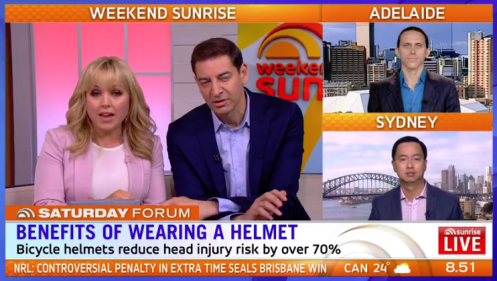
Spreading myths on Australian TV when trying to debate helmet laws.
In essence, the study compared those with head injuries both in helmets and not, against those with any injury in both helmets or not, and calculated an odds reduction of 69% for a serious head injury and 65% for a fatal one. For any head injury it’s a 50% odds reduction, and for face injuries a 33% odds reduction. Who wears helmets over the face? Bizarrely, and despite results in other studies, Olivier found no increase in neck injuries among helmeted cyclists compared to those without.

No surprise, the host and key helmet hysteric, Basil Zempilas, goes without a helmet.
Like the Seattle study, Olivier ignores several key factors. The first omission is excluding total odds of a crash in the first place. Cycling is very low risk, with a key recent example of the bike-share scheme in New York City recording its first fatality after 43 million rides. If we extrapolate the 65% odds reduction of a fatality to NYC’s bike-share scheme, all that the helmet does is reduce the chance of death from a 1 in 43,0000,000 to 0.35 in 43,000,000. Is that really justification to make it illegal to ride without a helmet anywhere, anytime? In this New York case, the rider went under a bus, rendering a helmet useless anyway, so such cases should be wiped from the statistical analysis. While you may argue hypothetically that there could be some injury reduction by those wearing helmets, we do actually know very few bike-share riders wear helmets anyway, and the low-risk outcome remains consistent with other studies, particularly of other bike-share schemes and general urban and utility cycling.
Then there’s the ratio and types of people riding with and without helmets in the first place. Considering the data is mostly European, helmet wearing would be very low so there’s a false presumption the numbers represented in hospital data are in the same proportion as those actually cycling. That would be for any injury, not just head injury, yet Olivier doesn’t do an arm injury comparison. In a proportional sense, those wearing helmets and being hospitalised would most likely be sports cyclists, yet the data makes no distinction between this high risk category of cycling to the low risk urban style. Total risk is important when you want to start talking about egregious and pernicious nanny state laws. Even without this critical lack of context, factored in still must be the overall helmet wearing rates. If it’s 1 in 100 people, as is likely in much of the older data, then that dramatically closes the odds of a head injury between the two data-sets, if not showing the helmeted cyclist at greater odds.
Finally there’s the classic false presumption a helmet would have mattered, or a helmet was ever needed. For such an odds analysis to be remotely meaningful, you only look at known head strikes, compare helmet vs non-helmet outcomes, and factor in total helmet wearing rates and incidents per total cycling kilometres covered. That way you get an overall risk level, and the result would be very low percentage, for example 0.00000023% would be the odds per ride for the New York bike-share example and the odds reduction something like 0.00000016%. It seems all Olivier has done is found a convenient equation to produce the most sensationalist and fraudulent result possible. It’s junk science at its worst. When I queried Olivier on twitter (@JakeBioStats) about these matters, I was blocked. Says it all.
HOSPITAL DATA STILL SHOW THERE ARE HEAD INJURIES!
Yes, and nearly all from road-related sources are motorists, motorcyclists and pedestrians!
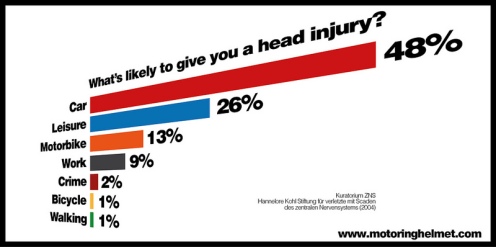
There’s also dozens of people drowning each year at beaches that would otherwise be saved had they been wearing a life jacket. Alcohol causes countless problems, notably domestic and street violence. Then there’s general poor lifestyle choices, which hospital data shows is by far the largest contributor to premature death and the actual problem crippling the health system. Cycling crashes are barely a blip on the health system, and overall, cycling is a net health benefit to the population – estimated at least 20/1 vs the risk of a serious crash.

New South Wales total road fatalities by user class
You need to look at total risk at population level, and it’s so small that to force this one sector of the community to be subjected with such an onerous law, it reeks of discrimination. A Monash University study (PDF Download) showed motoring helmets would reduce the road toll by 40% and slash tens of thousands of head injuries each year. If saving lives is so important, then surely the group causing the biggest problem should be wearing helmets, and that’s motorists.
A CYCLIST WAS KILLED ON THE ROADS AND WASN’T WEARING A HELMET
The classic false presumption of automatically believing a helmet would have prevented death or even a crash in the first place. It’s a common mistake of many an activist, advocate, and even fraudulent researcher, that an injured non-helmeted cyclist automatically goes onto the “preventable injury” list. Unless you repeat the crash exactly, there’s no way to know whether a helmet would have helped, or even mattered. Would the cyclist have been riding as fast, or even taken the same dangerous route? This phenomenon of “risk compensation” is well documented in human behaviour, whereby in the belief they are safe, they take risks they ordinarily would not. A study even showed motorists pass closer to cyclists wearing helmets.
I CRASHED AND CRACKED MY HELMET, IT SAVED MY LIFE!
No it didn’t. Your helmet failed. They are not meant to crack. Helmets work by absorbing the impact, which would leave a depression in the helmet. That is exactly the test they undergo before being approved. A 2-metre drop to the crown attached to a 5kg sphere to simulate a head, and if the helmet cracks, it fails the test. It’s the same in real world use. Otherwise, the best it’s done is possibly prevent a skull fracture. More likely, it only prevented a graze or cut, and in a worse case scenario, it caused the impact because the bulk of the helmet increases the size of your head up to 40% so no blow or a glancing blow becomes a thumping blow.
Anecdotes don’t justify a law anyway. If so, it would be illegal to leave the house without a helmet, and certainly illegal to ride in a car without one. Even in a house, walking down stairs would require a helmet. Curiously with these anecdotes, they come from people where helmets are optional, so if you’re already wearing a helmet for your dangerous cycling, why do you need a law? Also note how all these anecdotes are almost always from fast and dangerous cycling. Training rides, riding downhill in the rain, mountain biking… it’s never “I was cruising through a park at slow speed and suddenly flipped onto my head”. Nor is it, “I was hit by a car, smashed by head and survived”. The former scenarios don’t happen, while the latter ones are typically fatal. Remember, we’re talking about a law that BANS any cycling, anywhere, anytime, without a helmet. Just because a helmet law would happen to fit your personal lifestyle choice, it doesn’t make the law right.
HELMETS ARE BASIC SAFETY EQUIPMENT
Helmets are mostly useless safety equipment. These flimsy foam hats are set to a standard for road racing, which is on closed roads and where most crashes are of the skidding, sliding or somersault nature. As protection on roads against a motor vehicle, they simply were never designed for that and to absorb a serious impact. The impact rating to past the safety standards is just 20 kph, and that presumes the strike is to the crown of the head, the helmet is the correct size, and fitted low, snug and tight. If not, you can halve the safety rating, and even more so for a strike to the side of the head. Helmets easily become brittle too, and must be replaced about every 5 years and not left in weather. As for the most serious types of head injures – concussion and diffuse axonal injury – helmets do nothing. The deceleration process they provide is simply too insufficient to reduce concussion, while their bulk and grippy nature when contacting the road increases rotational forces and therefore creates a higher likelihood of diffuse axonal injury.
HELMETS MAKE CYCLING SAFER
Helmets make crashing safer, and only marginally at that. Considering 95% of all serious cycling accidents involve motor vehicles, to truly make cycling safer, you remove the threat, not futilely try protect against it.
HELMETS SAVE LIVES!
Helmets kill lives! They do it in 5 insidious ways:
1) Risk compensation. Cyclists engage in more dangerous, reckless and faster riding, and in more dangerous environments. This is a common phenomena, and seen in many other activities, notably American Football, snowboarding and skateboarding. Adding physical protection adds a degree of invulnerability and therefore people will engage in riskier activities ordinarily they wouldn’t.
2) The exaggerated protective values of helmets induces people onto busy roads. Even if they ride carefully and slowly, the whole “helmets will keep you safe” mantra is folly in the real world, and ultimately and sadly, lures cyclists to their death.
3) Governments place helmet laws at the forefront of their cycling safety policies instead of the only true safety measure: separation from vehicles. Noting that 85% of serious injuries and almost all fatalities involve a vehicle, then it’s totally irrational that the focus is on trying to mitigate the damage caused by a crash, not trying to prevent the crash altogether. Separation Saves Lives.
4) Perception of danger. The more you promote helmets, and the more extreme a helmet law becomes, the more you promote cycling as dangerous, the less people will ride or will consider riding. This reduces the “safety in numbers” effect, meaning there’s less attention and awareness by motorists watching for them, and therefore increases the danger for the remainder of the cycling population.
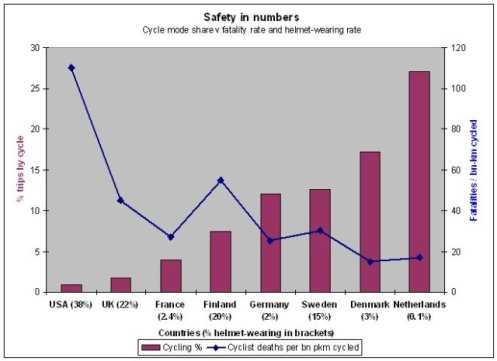
5) Lost health benefits. It’s well documented the total health benefits from riding a bicycle outweigh the risks by 20 to 1. A recent British study showed that regular riders reduce their chance of any form of early death by 41%, incidence of cancer by 45% and heart disease by 46%. A New Zealand study showed cycling activity halved following their helmet laws and it’s estimated that’s created an extra 53 premature deaths a year. A large study in Denmark found that commuter cycling for just three hours a week led to 39% fewer deaths (from any cause, including heart disease) compared with non cyclists, taking into account other leisure time physical activities and other explanatory factors. Given the health crisis due to lack of exercise, it makes no sense for police to be targeting someone doing something good for their health and the environment.

Save lives, wear a motoring helmet: Don’t hit the gas without one!
If the “helmets save lives” chanters had any real credibility, they’d be demanding helmets me made compulsory for those suffering the most amount of head injuries in our society: motorists. In fact, for teenagers, car crashes are the leading cause of fatal head trauma.
NEARLY EVERYONE WEARS A HELMET SO HELMET LAWS WORK!
Only by decimating the cycling population and discouraging new cyclists, leaving mostly the high-speed sports and commuter types, who would wear a helmet anyway. Yes, while the percentage of cyclists wearing helmets might be high, the total number of people cycling is low. Worse than that, they are not any safer. This is well documented in a Canadian study of hospital data among the varying provinces that found helmet laws had a minimal effect to reduce injuries. The simple reason is that people can decide for themselves, and this is mirrored in real world observations where sports and cycling enthusiasts wear helmets even when the casual, utility and urban riders almost exclusively go without.
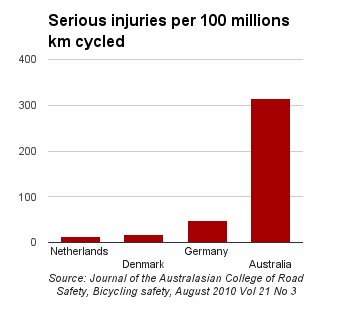
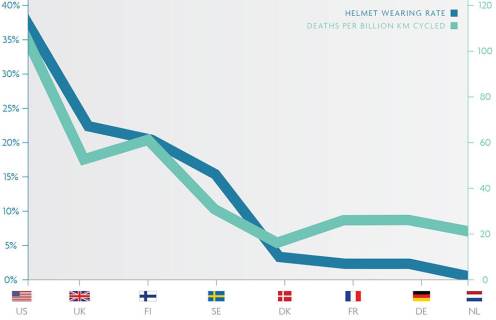
Also observed is the higher the helmet use, the less riders there are overall, and the more dangerous it is for them. Great work!
YOU CAN CRASH ANY TIME, EVEN AT WALKING PACE, AND SMASH YOUR HEAD
Classic proof of the hysterical perception of danger helmet laws have created. Sadly, most Australians truly believe riding a bike is suicidal and never safe, and that without helmet laws, no one would wear a helmet and millions would be dead or injured. No wonder the idea of riding a bike is so undesirable. This nonsensical scare-mongering permeates through the entire community, including the media and police, and deflates any chance of a rational discussion. Not to forget it’s totally disproportionate to the protective value of a helmet anyway. The fact such few people ride shows there’s little faith in these flimsy foam hats. While people might be ignorant, they’re not stupid.
EFFECTS OF HELMETS UNDER-REPORTED BECAUSE HELMETS PREVENTED A HEAD INJURY AND CYCLISTS DIDN’T GO TO HOSPITAL
This is one of those “you can’t prove a negative” situations, and theoretically you could say there could be millions of these scenarios, or possibly none. In fact, it’s easy to dismiss this argument because in the simple investigation of a crash, particularly one that would be violent enough to suffer a serious head injury, is that there would always be other injuries, particularly to arms and shoulders. The human instinct is always to throw the arms out to protect from a fall, and even in a case that the speed of the crash prevented a full arm extension to brace the fall, there’d be violent contact with the shoulders or other parts of the body.
HELMET LAWS SAW ARM INJURIES REDUCED COMPARED HEAD INJURIES
Jake Olivier strikes again, this time with Australia’s other main helmet hysteric, Raphael Grzebieta. They produced a report (again based on hospital statistics bereft of context) that showed the ratio of arm injuries to head injuries went up after helmet laws started, implying that helmets were reducing head injuries. One problem: Olivier doesn’t factor in that that cycling rates significantly reduced after helmet laws started, especially for children, and since the overall head injury count remained roughly constant, the raw data actually shows cycling became more dangerous after helmet laws. The study is fully debunked here.
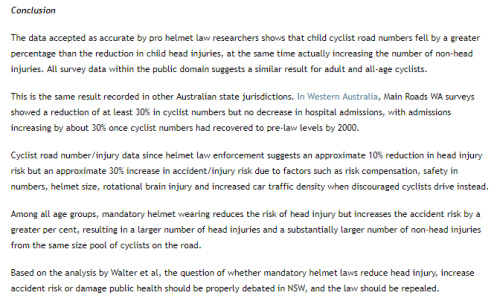 Curiously, motoring and pedestrian fatalities reduced after bicycle helmet laws started, so they really had a strange effect! The problem with such reports is they don’t take into account other improvements being made at the time: lower speed limits, speed cameras, booze buses, education, and even bicycle lanes – and downward trends were already well in place before helmet laws.
Curiously, motoring and pedestrian fatalities reduced after bicycle helmet laws started, so they really had a strange effect! The problem with such reports is they don’t take into account other improvements being made at the time: lower speed limits, speed cameras, booze buses, education, and even bicycle lanes – and downward trends were already well in place before helmet laws.
 In New Zealand, data also shows that injuries went with the arrival of helmet laws.
In New Zealand, data also shows that injuries went with the arrival of helmet laws.
SURELY IF YOU HIT YOUR HEAD A HELMET WILL HELP
This is true for countless activities, notably riding in a car, skiing, clubbing on a Saturday night or walking down stairs, so why are we discriminating against one sector of the community with a fascist law when our helmet evangelism could be doing much more effective work elsewhere? Of course, no one is stopping you from wearing a helmet in a car anyway. Even on a bike, continue to do so. The issue at hand here is using the full force of the law to force people to wear helmets and turning a normal and safe activity into an illegal and oppressive one.
IF HELMET LAWS SAVE ONE LIFE IT’S WORTH IT
See above.
DOCTORS SUPPORT HELMET LAWS
Depends who you ask. Most fall into the nanny state mentality that helmet laws work and talk about the head injuries they see. Of course, most of those injuries would be motorists, so it raises the question why their conscience doesn’t pause at the idea of motoring helmets. I’ve queried dozens online about this hypocrisy and everyone single one has run silent. No doubt they don’t want the Sunday drive in their convertible sports cars ruined. Like most helmet extremists, these doctors don’t see beyond their own personal lives. They don’t ride, so the law is no bother to them. Nor do they realise the devastating effects of helmet laws on the general health of the population. Less exercise means less healthy. It’s simple.
Then there’s doctors that do break from the helmet hysteria convention. Finnish neurosurgeon, professor Jari Siirone, who questioned the helmet obsession, saying “If the spirits (alcohol) were banned in the world, I would become unemployed. If bicycle injuries disappeared, I would not even notice it”. British neurosurgeon, Henry Marsh, said he sees “sees lots of people in bike accidents and these flimsy little helmets don’t help”. They are too flimsy to be beneficial. Australian Jeffrey Rosenfeld doubts helmets protect much against the most serious type of brain injury, diffuse axonal injury (when the brain is shaken up), saying “I don’t know if [helmets] do much to protect the inner part of the brain”. Neurosurgeon and concussion expert Rosamund Hill from New Zealand argues similarly, “They’re certainly not going to prevent a brain injury or concussion, I don’t think there’s any doubt about that”. She actually queries whether helmets could be better, “You may reduce the chance of a serious head injury depending on how you land or where you’re hit. The argument really should be whether the flimsy helmets people wear are good enough.” Helmets were less flimsy once, complete with hard-shells and poor ventilation. Standards were changed to make them more bearable to wear.
HELMETS ARE WELL ACCEPTED AND EVERYONE WEARS THEM
If that’s the case, why do you need a law to force them? Facts are, there’s thousands of helmet fines each year, which would only represent a fraction of cyclists going without a helmet. There’s a clear constituency of riders that don’t want to wear a helmet, yet we have a punitive law with fines over $300 trying to stop them. Most would be the casual types in low risk environments, and clearly the exact people we don’t want to dissuade. Whereas the enthusiasts, as represented in the Bicycle Network survey, would still wear helmets regardless of the law. At worst, drop the fine to $20; at best, start by exempting adults on paths and low speed roads, as per a review by the Queensland state government. People can judge risk for themselves and make their own choice.
CYCLISTS ARE VULNERABLE
Vulnerability does not equal risk. People are vulnerable to shark attacks. Do we ban them from ever entering the water? People are vulnerable if a plane crashes. Do we make them wear parachutes? No. Both those activities, much like cycling, are incredibly low risk.
GOVERNMENT DOESN’T WANT BLOOD ON THEIR HANDS IF HELMET LAWS ARE REPEALED AND SOMEONE DIES
Yet they don’t care when time and time again a helmet has failed to save a cyclist’s life? This is really a case of “I’ve done my bit, my conscience is clear”, and it’s this mentality that has seen infrastructure ignored and more cyclists dying than ever should have. Sorry, government already has blood on their hands, not to forget all the health problems and early deaths in the population because of their inaction, preferring instead to marginalise a safe and life-saving activity like cycling. If they had any conscience they would end this war on cycling, dump the anti-cycling laws and try foster a pro-cycling culture. Their attitude should be “while we’d prefer to see you in a helmet, we just want you riding anyway”, and then get with the program and implement safe riding routes across the city and lower speed limits in urban areas.
RACING CYCLISTS WEAR HELMETS
It might be the fact they race at high speeds, race in tight packs and crash far, far more often, that has something to do with it. They are also racing in a controlled environment, away from motorists, where the helmet is more likely to be of some value. Their helmets are also superior, costing several hundred dollars, meaning they’re far more cooler and comfortable. Race speeds of typically 50 kph mean there’s a huge amount of airflow through the helmet too, so much so that designs can have fewer ventilation slots as the speed creates a venturi effect. Finally, these are super fit athletes with support vehicles following with plenty of water to pour over their heads. It’s a nonsense comparison… unless you want to make the extrapolation that if race-car drivers wear helmets, so should motorists. Why You Probably Shouldn’t Listen To Pro Cyclists On The Helmet Debate
MOTORCYCLISTS MUST WEAR HELMETS, SO WHY NOT CYCLISTS?
Another nonsense comparison. Not only is there the huge differences in speed and danger, motorbikes mix directly with traffic and are propelled with powerful motors. No one is peddling those things, so there’s no heat build up due to physical exertion, therefore motorcycle helmets don’t require ventilation. Furthermore, owning a motorcycle requires licensing and registration, so it’s part of the conditions of acquiring a motorbike that there are certain laws to abide by. If a helmet is unappealing, then buy a car. No one’s forcing anyone to ride a motorcycle. Whereas a bicycle is meant to be the transport of the people; something anyone can simply pick up and go.
MOTORISTS ARE REQUIRED TO WEAR SEATBELTS SO CYCLISTS SHOULD WEAR HELMETS
Again, a nonsense comparison. A seatbelt is not a suffocating piece of foam strapped to the head. There’s no resistance movement to compulsory seatbelts. Seatbelts don’t discourage car use, and they also have plenty of exemptions – notably for delivery drivers, tractors, buses, vintage cars and any vehicle not travelling over 25kph. Seatbelts also have a fundamentally different role of preventing occupants smashing into the interior of the car. Even then, they are useless in a side impact or rollover. Beyond that, there’s zero protection other than airbags, and they can fail or are not available in all cars or all parts of a car, and they’re not designed for children either. Seatbelts are proven to do be highly effective whereas a bicycle helmet is mostly useless. Seatbelt laws are almost universal around the world whereas, after 25 years of Australia’s supposedly “world leading helmet laws”, they are rarely seen elsewhere. Not that a bicycle is even remotely comparable to a car, with each being fundamentally different modes of transport. One can be cruising around off road or in a park at 10kph, while the other is lethal missile zooming about at speeds over 100kph.
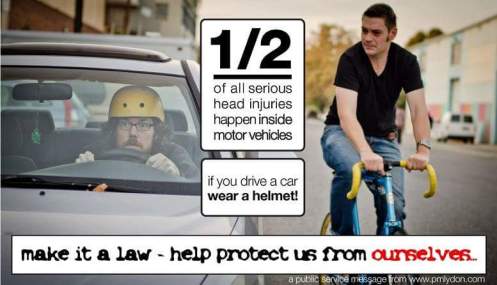
The correct comparison to a cycling helmet would be a motoring helmet, and it would actually save hundreds of lives and help prevent thousands of head injuries. So why not a motoring helmet law? If it only saves one life it’s worth it.
EVEN IF MOTORING HELMETS WORKED, THEY WOULD BE HARD TO ENFORCE
No harder than mobile phone use, and especially no harder than drink driving. Helmetless motorists can be easily spotted by police, whereas driving under the influence can only be caught by a random stop. The point here is the message that motoring helmets save lives, and if saving lives is the key determination with helmet policy, surely it should start with the area that contributes the most trauma and heartbreak to our society.
HELMETS DON’T STOP PEOPLE CYCLING
It must be a total coincidence then that countries with the lowest rates of helmet wearing have the highest rates of cycling. Census data also clearly showed cycling activity dropped, and it’s never really recovered.

Then there’s bike-share schemes, where Australia’s versions in Melbourne and Sydney are a disaster. Even delving into the theoretical, imagine if motoring helmets were required only for convertible cars, what impact do you think that would have on their sales? It would destroy them. If people in such cars can zoom about with their heads exposed at 100 kph, surely a cyclist can at 15 kph.
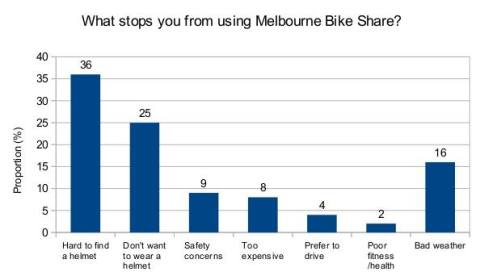
Melbourne Bike Share Survey 2013
Actual surveys do show helmets are a barrier, with a Sydney University study showing cycling rates could double without helmet compulsion. There’s also the indirect numbers with the major barrier of “cycling is too dangerous” – no doubt caused by the legal requirement and fear campaign to wear a helmet. Before helmet laws and in countries with high rates of cycling, cycling is correctly perceived as safe. Then there’s the unknown, those that try riding, hate the obtrusive helmet, so stop. Much of this would be subconscious too. A family goes for a ride on their new bikes, they suffer under the sweaty, oppressive foam hats, so the next time there’s a family outing, cycling is already vapourised from the mind and they do something else. Even ignoring the hypothetical barriers, that 25% that don’t like helmets translates to millions of people. There should be no barriers to cycling.
NO EXEMPTIONS UNTIL GOOD INFRASTRUCTURE
There already is good infrastructure, with plenty of specific off road paths and shared paths. So why not allow exemptions there? Indeed a review into cycling by the Queensland state government in 2013 recommended, for adults only, helmets not be compulsory in such conditions, or on roads with speed limits of 60 kph or less. They recognise, just like the Bicycle Network research, the vast bulk of deaths and fatalities are on busy, high speed roads. Of course, the minister rejected the recommendation, preferring to raise cycling fines to be equal with motorists in exchange for “close passing laws”. Other than the Northern Territory, which does not require helmets on paths and footpaths and has very low cycling fines altogether and the highest and safest cycling levels in the country, helmet laws are still a blanket law, except for some states allowing a religious exemption for those required to wear a head covering and for pedicab passengers.

Look, no helmets! Bizarre anomaly in Australia where pedicab passengers do not require helmets.
Waiting for good infrastructure means waiting forever. It costs nothing to change a law, and removing the helmet law simply means a normal and healthy activity – as seen all over the world – won’t be illegal anymore. Note that 99% of countries do not have helmet laws, and they all don’t have good infrastructure everywhere. It’s another cop out.
CYCLISTS SHOULD WEAR HELMETS OTHERWISE PAY THEIR OWN THEIR MEDICAL EXPENSES
They already do. Everyone pays into Australia’s public healthcare system so cyclists are covered. Many cyclists also own cars, and therefore pay compulsory transport accident insurance despite leaving their cars home most of the time. When you consider 85% of collisions involving cyclists and motorists are the motorists’ fault, then the entire cycling population is well and truly covered several times over. Then also consider the health benefits of cycling that keeps cyclists out of the healthcare system for much longer. That benefit far outweighs any risk of a cycling accident, helmet or not.
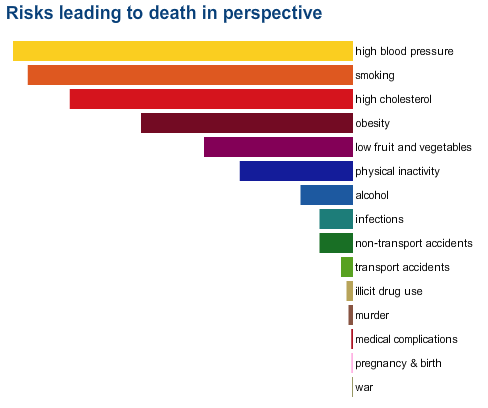
Leading causes of death in the United Kingdom in 2014
If direct culpability was the measure for paying own medical expenses, cyclists would be near last on the list. At the top would be those with lifestyles choices of low exercise, poor food, and alcohol, cigarette and drug use. Heart disease and obesity are by far the biggest killers – both of which cycling actively helps prevent. Skin cancer, something else primarily down to lifestyle choice, each year sees 2000 deaths, 40000 new cases and over 1 million medical interactions, yet where’s the demand for that cohort to pay their own way? There really must be a special hatred and disdain towards cyclists that they are the only candidates in society to be left to the mercy of their own hip pocket in their time of need. Disgusting.
REPEALING HELMET LAWS WILL MEAN MORE PEOPLE WON’T WEAR HELMETS
That’s the point. We want cycling to be seen as a normal, regular and safe activity, so when people go on an errand, the instinct is to take a bike. The more people seen not wearing helmets would actually be a reflection of more people overall riding bikes, not the existing population throwing away their helmets. The 25 years of fear campaigns and helmet hysteria will see to that, and the day after helmet laws were repealed you’d barely notice a change. Change would be very slow and generational. Helmet wearing rates are already high in other motor-vehicle dominated countries like the USA and Great Britain, while even in Europe, people are beginning to wear helmets more often. It’s more proof people don’t need a law to tell them to wear a helmet, and they certainly should not be subjected to police harassment and whopping big fines if they don’t wear one. As much as helmet-law advocates want to believe mass cycling uptake and mandatory helmets can work, there’s no evidence anywhere it can. You’ll simply never get a flourishing bicycle culture while promoting cycling as never safe and an extreme helmet enforcement policy is in effect.
WE NEED TO SET A GOOD EXAMPLE FOR CHILDREN, SO ANY EXEMPTIONS FOR ADULTS, EVEN ON SEPARATE PATHS, IS A BAD IDEA
Better ban alcohol, tattoos, smoking, adult media, prostitution and even driving! We see adults can’t handle some of these activities, killing each other on the roads and straining our hospitals with their poor lifestyle choices. To think it’s the one good, healthy activity of cycling that we ban.
MANY COUNTRIES HAVE HELMET LAWS, SO AUSTRALIA ISN’T ALONE
Australia is alone in having an all-age, no-compromise and aggressively enforced helmet law. Fines of over $300 in one state, whereas in Finland there’s no fine. Even within Australia, the Northern Territory has helmet exemptions on paths and footpaths, and cycling fines are only $25. Far more people ride too, and cycling is safer there. New Zealand’s police have largely decided to stop enforcing their law and capturing the $55 fine, citing a waste of police resources. In the United Arab Emirates, the helmet law is primarily to victimise immigrant workers, with bike confiscation the usual penalty. Elsewhere in the world, helmet laws are typically only for minors and in certain jurisdictions and, again, enforcement is lax with penalties minor. Spain is one of the more unique places, requiring helmets only outside urban areas, except if it’s hot or riding uphill. While some places are considering helmet laws (Korea with no enforcement and Singapore for roads only), many like Mexico, Israel, Malta and Bosnia & Herzegovina repealed theirs.


For an all-ages, no compromise, and rigidly enforced helmet law with extreme penalties, that will even see 7 police cars sent to stop a helmet optional ride through Sydney parkland, sorry, there’s only one such country in the world with this insane policy, and that country is Australia.
IF YOU WANT RESPECT ON THE ROADS, WEAR A HELMET, AND PAY REGISTRATION!
This is born from the absurd notion of achieving equality on the roads and earning respect from motorists. A bike and a motor vehicle can never be equal, and should not be classified together. Bicycles are their own unique type of transport and require their own specific laws and penalties. They are rarely a danger to anyone else, unlike a motor vehicle. Registration would solve nothing – in fact, would make many feel more entitled – and the idea is merely born out snivelling and vindictive motorists, jealous that cyclists get a “free ride” on our roads. Fact is, cyclist do pay for roads. Everyone does. The majority of roads cyclists use would be local ones, and that comes from local taxes. Not to forget many cyclists would own a car, so are contributing from that despite doing minimal damage.
WE CAN DO BOTH – HELMETS AND INFRASTRUCTURE
No you can’t. While the obsession is on helmets, infrastructure will always lag behind, luring more people to their deaths. Then there’s the continued perception that cycling is suicidal without a helmet, so how will that encourage anyone anyway? The idea to grab a bicycle should be as spontaneous and normal an activity as walking. Helmet laws and helmet obsession simply demoralise the idea of a bicycle as a means of general transport in the community so shouldn’t be even on the top 10 things to consider when it comes to safety and getting more people on bikes. You can either have a bicycle culture or a helmet culture, not both.
NO RESISTANCE TO HELMET LAWS WHEN THEY FIRST STARTED, AND IT’S STILL ONLY A MINORITY AGAINST THEM
Only in Australia. Whereas worldwide, there’s furious resistance to even a hint of adopting helmet laws, with opponents citing the disaster Australia as the reason. Even in Australia, initially everyone thought the laws were a joke, the fines were tiny, police wouldn’t waste their time, and no one envisaged the damage they would ultimately do. For plenty of years that continued, and it was only when motorists started whinging about cyclists “breaking laws” that authorities, with Australia’s sycophantic bike groups in tow, thought increasing fines and tougher enforcement was the way to earn respect from motorists. That’s clearly failed now, having the opposite effect, and among actual riders, the Bicycle Network survey shows the majority believe the laws should be relaxed.
BICYCLE GROUPS ALL SUPPORT HELMET LAWS
Again, only in Australia. Worldwide there is no appetite for helmet laws, citing the problems of adding a barrier to cycling, creating a culture of victim blaming, and turning a normal, safe and healthy activity into an illegal one. Compulsory helmets also kill the possibility of a flourishing bike-share scheme, and a flourishing bicycle culture in general. Australian bicycle groups have mostly followed the cult of helmet laws, knowing opposition would see them isolated from government recognition. Even worse, helmet laws and higher fines are callously linked to obtaining better cycling conditions and increased funding that ordinarily should come freely. You only need look in New South Wales at how the Amy Gillett Foundation became the nation’s most odious bicycle lobby group when they agreed to a 500% increase of helmet fines in exchange for a close-passing law. Just as in Queensland, that law is barely enforced anyway, so it was yet another betrayal to cyclists.
MOST AUSTRALIANS SUPPORT HELMET LAWS
Most Australians don’t ride a bike. It’s easy to support an obtrusive nanny state law when it doesn’t affect you. Australia’s cycling rates are appalling, and going backwards, and this is despite the National Cycling Strategy aiming to double cycling rates between 2011 and 2016. According to the National Cycling Survey, only 15.5% rode during the nominated week, down from 18.2% in 2011. Monthly and yearly figures are also down.

The most recent census of 2016 showed only 1.1% of commuters went by bicycle – down from 1.2% in 2011.
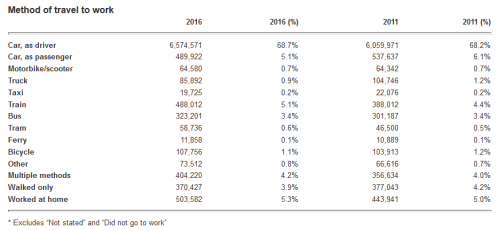
Most cycling, around 80%, is recreational. These would be the weekend warriors with their lycra, carbon bikes and fancy helmets that most commonly dominate Australia’s bicycle scene, whereas transport cycling is only 30%. As a measure of a flourishing bicycle culture, this is totally disproportionate to that required. Of that 30% transport cycling, about 10% is commuting, with the rest comprising school, shopping, friends and relatives, and public transport.

Cycling policies so far have been an abject failure, with helmet obsession, and the law itself, stifling progress. The actual focus should be on those not cycling, and you simply won’t encourage anyone with the negative message that cycling is dangerous and cycling requires an uncomfortable helmet. Helmet laws are the central cause of that and it’s no wonder so many people are not interested in riding.
DON’T WEAR A HELMET AND SIMPLY PAY THE FINE
At almost $330 in New South Wales and $200 in Victoria, that’s an expensive bike ride. It also doesn’t mean you’re absolved from wearing a helmet for the day. In fact, one of the peculiarities of the helmet law is that you’re perpetually in breach of the law until you stop riding. Upon being fined, you’re to walk the bike, or be fined again and again. Police will often deflate tyres.
HELMET LAWS ARE NOT HIGH PRIORITY SO STOP FOCUSING ON THEM SO MUCH
While helmets are compulsory by law, they’ll always be a focus, and always be the priority for cycling advocates that want cycling to be seen as normal, safe and convenient. It costs nothing to reform the law and make cycling more appealing, and if this small liberty can’t be obtained, then everything else is compromised, as already seen with massive increases in fines, tougher enforcement, and worse cycling and safety outcomes.
MANY OF THOSE AGAINST HELMET LAWS ARE REALLY AGAINST HELMETS ALTOGETHER
False impression. Feel free to wear a helmet, knock yourself out. Specifically the problem is helmet promotion. Places like Denmark that has seen more promotion is starting to see a cycling decline. It’s quite simple: promoting helmets means promoting danger, especially if the promotion is excessive. Subconsciously, people switch off completely from the idea of riding a bike, when in reality it should be an instinctive choice. Promotion is fine if it’s accurate, like wear a helmet if you’re a novice, or it makes you feel secure, or are engaged in a more riskier forms of cycling. Just don’t rely on it to keep you safe, especially on busy roads. It doesn’t prevent or reduce the chance of a crash. In fact, it’s more likely to contribute to one. It’s a device of last resort and only ever designed to offer superficial protection.
JUST WEAR ONE, IT’S NOT THAT HARD
Yes it is. These are bulky head coverings are made of foam, which is designed to trap heat. The ventilation slots, while often looking impressive, only cool a few spots on the top of the head. Much of the head, up to 80%, is either in contact or in very close contact with foam and padding, and it doesn’t take long for heat and sweat to build up, and itching to take place. They are uncomfortable, and oppressive, and most people simply tolerate them. Often this “just wear one” attitude is by people that don’t cycle, yet watch them recoil at suggestions motorists should wear a helmet.
HELMET LAWS SEND A GOOD MESSAGE
The genesis of mandatory helmet laws, and the prevailing mindset that fuels advocates ranging from clueless bureaucrats to the most strident of helmet zealots. They believe helmets are a good idea and therefore a law is a good idea. Except they never fully realise the consequences of using the law as advocacy: laws require enforcement, prosecution, deterrents and sanctions. With that comes a harmless group of people persecuted, and an activity marginalised and ostracised. What started as a trivial offence and trivial fine in Australia has grown into one seen as bad as a motorist speeding through a school zone, with fines to match. Then there’s the dreadful impact on cycling itself, with shocking outcomes for both riding levels and safety, not to forget the poor health outcomes. So the good message ultimately has become the bad message. Cycling is dangerous. Cycling is never safe. Only a helmet can save you. Only a law will make you wear one. If you dare not wear one, you’ll be harassed, humiliated and punished. Yes, it all started with this seemingly trivial and good intentioned idea to use the force of the law to advocate helmets. It’s failed miserably, and now it’s time for this disastrous 25-year experiment to end.

Cycling in Copenhagen, Denmark
More: Australia the arse end of the world for cycling
Excellent summation of the issues. If you didn’t make a submission to the WA “Inquiry on Personal Choice and Community Safety” submit this and ask that it be accepted as a late submission.
http://www.parliament.wa.gov.au/parliament/commit.nsf/($all)/7CD5D225E7FF118C482582F80027F2B7
Regarding your post, I love the comparison of seat belts, motorcar travel is well beyond the tolerances of the human body to impact, whereas a casual bike ride is well within.
Regarding infrastructure, I’m certain that the risk compensation extends to designers that build “helmetfrastructure” – utterly sub-par bike facilities that passed some subconscious test in the designers mind that “oh well, riders will have helmets anyway.” You only need to look at half the insane rubbish in Melbourne to see this.
As for your assertion “as bad as a motorist speeding through a school zone”? I challenge that. Drivers speed like crazy past schools in my area, business as usual. Somehow my casual roll along the footpath without headgear is tantamount to terrorism. This law has perceptions utterly backwards.
Regards.
I’ll try make that submission.
Many of those bike lanes are just vanity projects so politicians can pat themselves on the back that they are “doing something”.
About “as bad as a motorist speeding through a school zone”, I mean cycling without a helmet is seen, or perceived, as that, especially when the fines for each are the same if the excessive speeding is in the lower range. In fact, as you say, “somehow my casual roll along the footpath without headgear is tantamount to terrorism”, it’s seen as even worse. The levels of hysteria are ridiculous, and way disproportionate.
A very good article. Makes way to much sense. The Helmet pushers won’t get past first paragraph unfortunately.I do wear a helmet when racing and training. But happy to go to shops with out it.
Very good summary! Too many underestimated the damaging “side-effect” of Mandatory Helmet Law.
Fundamentally, Law should be introduced to control a potentially high-risk person for the protection of “others” from that person.
It is against logic and common sense to introduce a law that is solely for the safety of the personal self.
For example, why there is no law to stop people from jumping into a river or jumping from a height above 5 meters. Both are a dangerous action, isn’t it?
Lawmakers should be very careful and must have solid statistical data to back up the benefits when considering to mandate action that is solely for own safety, e.g. wearing a seatbelt.